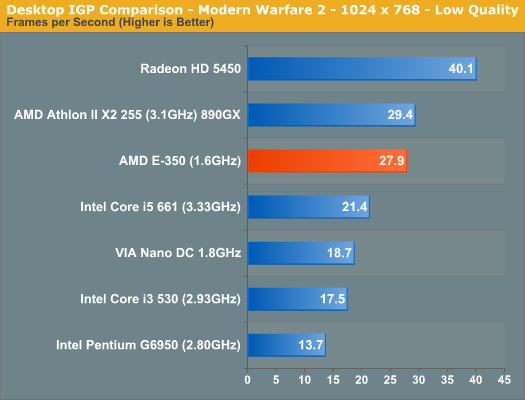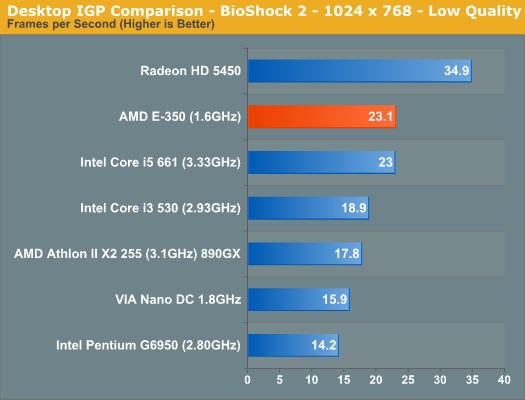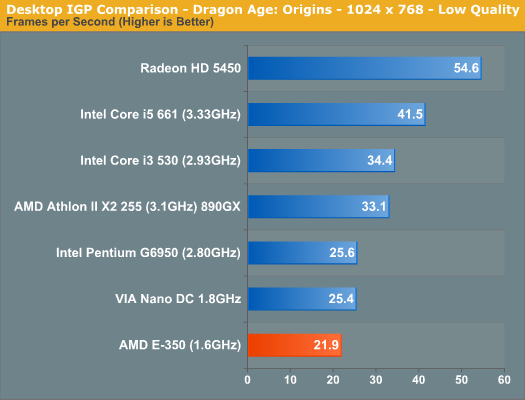The Brazos Performance Preview: AMD E-350 Benchmarked
by Anand Lal Shimpi on November 16, 2010 12:01 AM ESTDesktop IGP Comparison: Faster than Clarkdale
I split the graphics comparison into two sections: desktop and mobile. For the desktop section I compared the E-350 to the latest Clarkdale chips, AMD's own 890GX and a discrete Radeon HD 5450 graphics card. While the Radeon HD 5450 has the same number of shader processors as the E-350 (80), they run faster and it has a dedicated 1.6GHz memory bus to feed it. The E-350 has to share memory bandwidth between the two Bobcat cores and the 80 SPs, severely limiting its performance potential.


The E-350 does extremely well compared to its desktop brethren. In our Modern Warfare 2 and BioShock tests its easily faster than the Core i3/i5 and in the case of BioShock 2 it's even faster than AMD's 890GX. Dragon Age Origins is another story however as the benchmark is primarily CPU limited, giving the desktop parts a huge advantage. In GPU bound scenarios, it's clear that our initial Zacate benchmarking was accurate: the E-350's Radeon HD 6310 is quicker than Intel's HD Graphics.
Compared to the Radeon HD 5450 the 6310 offers between 66 - 69% of its performance in our GPU bound tests. The performance reduction is entirely due to the 6310's limited memory bandwidth being shared with the dual Bobcat cores on-die.











207 Comments
View All Comments
mino - Tuesday, November 16, 2010 - link
Why else would anyone spend 90% of the space boasting about multithreaded benchmarks that are COMPLETELY meaningless for the target markets?Anand, it is a sad fact that you are not humble enough to do a proper review of the low end stuff anymore.
Leave the space to people who are not so pampered by having the top-end stuff to play with for over a decade.
Stick to the luxury stuff where your mind is. Your time as a "mortal" reviewer is over.
You are far too out-of-touch to not get manipulated by PR lads without realizing it. As far as low-end and mainstream parts go, that is.
Anand Lal Shimpi - Tuesday, November 16, 2010 - link
These days it's actually very difficult to find workloads that don't at least stress 2 cores, even installing Modern Warfare 2 on the Brazos system ate up 61% of the 2 cores. That's why the Cinebench test is so handy because it does give us an idea of single threaded performance as well.Single threaded performance does matter quite a bit to how fast the system feels. Application launch time and how quickly windows pop up is greatly based on this, which is why I pointed it out in our single threaded performance results.
I tried to show single threaded performance, multithreaded performance in both high and low IPC workloads as well as a lot of gaming performance data to present as complete of a picture of Brazos' performance as possible.
If I've failed in doing so by your standards I do apologize. I wanted to run a lot more but with time constraints on how long I had access to the platform I had to limit what I could run.
Take care,
Anand
mino - Tuesday, November 16, 2010 - link
I am pretty sure you have a very good understanding of Zacate's performance.Where I see the problem that your articles have, over the years, come to be written from an upper class POW.
As if subconsciously disregarding the pricing part.
Then when a part comes out that is _designed_ to be cheap first and anything else second you make an article sound as the part was a piece of crap by definition.
While i certainly hope it was not the idea, it is how it came out ...
People are subjective by definition and our lives DO affect our expressions however much we would like it to stay otherwise.
mino - Tuesday, November 16, 2010 - link
One just needs to contrast the tone of this article with the Atom one. While Atom was being heavily praised for delivering acceptable performance for a low price an power.link: http://www.anandtech.com/show/2537
Nevermind that Silverthorne, while itself good, represented very much a crappy and imbalanced platform. (Outside the non-existent MID market.)
Compared to that Brazos, while almost shouting out "Atom done right" gets a stamp of "undewhelming" ...
Anand Lal Shimpi - Tuesday, November 16, 2010 - link
I appreciate the feedback. It's not my intention to discredit value as a piece of the equation, in fact pricing is always a major component of anything we discuss here.I believe we need to look at Atom in context. Two years ago Atom's level of performance might've been a decent balance of perf/power, especially given the price of good systems at the time. Today that is no longer true. Outside of smartphones, the overwhelming response tends to be that Atom based netbooks running Windows 7 aren't exactly fast enough.
The E-350 is clearly faster than Atom. My worry is that the E-350 won't be the chip aimed at Atom. In a $299 netbook the E-350 would easily trump anything else out there. But if we're talking about $500, then you start getting into Pentium DC and Core i3 territory.
While video encoding, 3D rendering and file compression/archive recovery aren't the only things you'd do with such a system, these are good tests of CPU performance which is the unknown we were looking to answer in this article. The tests told us three things:
1) The E-350 is faster than a dual-core Atom by varying amounts depending on the type of workload (the tests also highlighted the limits of Bobcat's front end in high IPC workloads).
2) The E-350 does achieve AMD's design target of 90% of the performance of a K8, and
3) The E-350 does suffer the same fate as Atom does when it comes to CPU performance. You can get a faster CPU in a similarly priced system, although you will likely give up form factor and/or battery life.
The E-350 is easily better than Atom, but when it comes to the Pentium/i3 comparison you have to make the tradeoff between CPU performance or GPU performance. I simply tried to present enough data to allow users to understand that tradeoff.
Take care,
Anand
mino - Tuesday, November 16, 2010 - link
Just try more care when publicly judging stuff by your personal expectations.Very few people will get the subtle praise in the background which a mere recognition of Zacate competing with mainstream platforms represents.
Thanks for the reply and keep up the good work,
Cheers!
mino - Tuesday, November 16, 2010 - link
It now came to me that what was really called for is a three-progned look at Brazos:1) as a netbook/ultra-thin solution
2) as a HTPC solution
3) as an ultra cheap alternative to mainstream parts
IMO it shines in all those roles but for a VERY different reasons:
1) solves GPU bottleneck that plagues this market since inception
2) provides Atom-class power with CULV-class connectivity and performance
3) is the cheapest kid on the block while providing _acceptable_ performance across the board (outside workstation tasks)
Maybe a topic for a follow-up analytic article ? :)
JarredWalton - Tuesday, November 16, 2010 - link
I would LOVE to have a netbook/ultraportable laptop to test right now using Brazos, but that's not what AMD is ready to show just yet. They're showing early hardware that needs the big OEMs to put it all into a compelling package. Unfortunately, I think they're going to fall short as well. Do you want an alternative to ION netbooks? This will definitely work, and even come out ahead. But ION, frankly, isn't good. Yes, it can play multimedia content a lot better than just Atom (or Atom with CrystalHD), but then so can ULV stuff.And the big problem is that you can get ION netbooks for $500, and ULV starting at $600. (http://www.newegg.com/Product/Product.aspx?Item=N8... So if AMD were to say that Brazos is going to target the $300 to $350 netbook world, I'd be ecstatic. When they say it's going after the $500 laptop world, I'm a lot less impressed. Intel already has CULV laptops that cost under $500; add in a G 310M (which is still too slow for most recent games) and you'd have something faster than Brazos in pretty much every way. It's just nothing special.
Is it a bad design? No. Is it an awesome design? Equally, no. It's an okay design that will fill a niche--a niche that already has plenty of options, unfortunately.
mino - Wednesday, November 17, 2010 - link
Well, Jared, I was hoping there is a chance for AT to recover.After this reply of yours, I am pretty sure you have lost the ability to see the forest behind the trees.
I will still not call you paid, but you are REALLY pushing for that.
Never mind, just no more hope left.
silverblue - Thursday, November 18, 2010 - link
Jarred didn't write the preview. He's entitled to his own opinion.